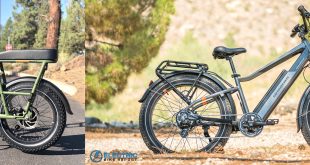What’s Behind The Giant Company’s Success?
When we talk about a “giant company” in the electric bicycle world, we’re not just talking about scale; we’re talking about influence, innovation, and shaping the way people move sustainably. So, what exactly is behind the meteoric rise of these industry titans? Buckle up—this is going to be an electrifying ride through technology, strategy, and sustainability.
1. A Culture of Innovation and Adaptation
At the core of any successful company lies relentless innovation. For giant companies in the e-bike industry, it isn’t enough to simply assemble bikes—they obsess over technical details like:
- Motor efficiency: Modern e-bike motors, especially hub motors and mid-drive systems, are engineered for torque optimization and energy efficiency.
- Battery management: Advanced lithium-ion batteries now use smart BMS (Battery Management Systems) to prolong lifespan and prevent overcharging.
- Integration: From digital dashboards to app-controlled settings, seamless integration creates an intuitive user experience.
My first encounter with a high-end e-bike from a leading brand was eye-opening. The way the motor adapted to my pedaling style and the battery range displayed on a sleek screen made me realize this wasn’t just a bike—it was a smart mobility device. Companies like these invest heavily in R&D, constantly testing prototypes in real-world conditions, ensuring they stay ahead of competitors.
2. Quality Control and Reliability
Success isn’t built on flashy marketing alone—it’s grounded in reliability. Giant companies have rigorous quality control pipelines:
- Multiple-stage inspections: From frame welds to electronics, every component undergoes strict testing.
- Data-driven analytics: Sensors and testing rigs measure performance across thousands of cycles, predicting potential failures before they reach the customer.
- Customer feedback loops: Online communities and service reports feed directly into product improvements.
I remember renting a commuter e-bike from a renowned brand. Even after riding 120 km in a week through urban traffic, hills, and rain, the performance stayed consistent—proof that quality control isn’t just a buzzword; it’s a lifestyle for these giants.
3. Strategic Branding and Community Engagement
Branding isn’t just about logos; it’s about creating a movement. Giant companies excel at building communities around their products. Through social media campaigns, user stories, and riding events, they make every customer feel like part of a larger mission: sustainable urban mobility.
Example: I attended an e-bike demo ride hosted by a major company. What struck me wasn’t just the bikes—it was the shared enthusiasm, knowledge exchange, and hands-on workshops for maintenance and riding techniques. This kind of engagement converts buyers into loyal advocates.
4. Embracing Sustainability
Today, sustainability isn’t optional—it’s expected. Giant e-bike companies are leading by example:
- Eco-friendly materials: Using recycled aluminum frames and biodegradable packaging.
- Energy-efficient production: Optimizing factory workflows to reduce carbon footprint.
- Battery recycling programs: Ensuring end-of-life batteries are repurposed or safely disposed of.
When I switched to an e-bike for city commuting, my carbon footprint dropped significantly. Giant companies aren’t just selling bikes—they’re promoting lifestyle changes that align with urban sustainability trends.
5. Cutting-Edge Technology Integration
Technology is the engine of success. Here are some innovations driving the giant companies forward:
- Smart sensors that adjust pedal-assist levels automatically.
- GPS and anti-theft tracking embedded into the bike frame.
- IoT connectivity for real-time maintenance alerts.
- Regenerative braking systems in select models, adding extra efficiency on downhill rides.

One personal highlight was using an app-connected bike that not only logged my routes but also suggested energy-efficient riding modes for my commute. These tech-driven conveniences make the experience addictive and reliable, contributing directly to customer retention.
6. Practical Tips for Getting the Most from Your E-Bike
Tip #1: Battery Management – Avoid fully draining the battery. Partial charges extend longevity. I usually charge to 80% after daily commutes and notice less performance drop over months.
Tip #2: Regular Maintenance – Lubricate the chain, check tire pressure, and inspect brakes every few weeks. Giant companies often provide detailed service guides; follow them.
Tip #3: Smart Riding – Use pedal-assist modes strategically. For city rides, a mid-range assist level balances effort and battery life. On hills, switch to higher torque assist.
Tip #4: Secure Parking – Invest in quality locks. Many companies recommend integrated locking solutions compatible with GPS trackers.
7. Frequently Asked Questions (FAQ)
Q1: Why are some e-bikes more expensive than others?
Price often reflects quality of materials, motor efficiency, battery technology, and tech features. Giant companies invest in R&D, quality control, and sustainability measures—adding value beyond the bike itself.
Q2: How long does an e-bike battery typically last?
Most high-quality lithium-ion batteries last 3–5 years, depending on charging habits, temperature exposure, and ride intensity. Following manufacturer guidelines can extend battery lifespan significantly.
Q3: Are e-bikes suitable for all ages?
Absolutely! With adjustable pedal-assist levels and ergonomic designs, e-bikes can be customized for teens, adults, and older riders. Giant companies often provide detailed sizing charts and test rides for the perfect fit.
Q4: Can e-bikes replace cars for commuting?
For most urban commuters, yes. E-bikes reduce traffic congestion, cut carbon emissions, and offer consistent travel times even during peak hours. Anecdotally, switching to an e-bike cut my daily commute time by 20–30 minutes in a congested city.
Q5: What’s next for e-bike innovation?
Future trends include:
- Lightweight, solid-state batteries with higher energy density.
- AI-assisted riding modes that predict terrain and traffic patterns.
- Integration with urban smart mobility networks for optimized routing.
- Expanded use of sustainable materials in frames, tires, and electronics.
8. Lessons from Giant Companies You Can Apply
Even if you’re not building a multinational brand, the principles of success can inspire your personal or business goals:
- Relentless focus on quality.
- Community building and authentic engagement.
- Adaptation to new technology without losing your core mission.
- Environmental consciousness as a non-negotiable business principle.
Personally, adopting these lessons transformed my e-bike riding routine. Tracking performance, joining local rider groups, and committing to eco-friendly practices made commuting not only efficient but genuinely fun.
Conclusion
The success of giant e-bike companies is no accident. It’s the sum of innovation, quality, community, sustainability, and tech integration. From high-efficiency motors to smart apps, every element is designed to deliver a seamless, eco-friendly, and enjoyable experience. As cities grow and sustainability becomes imperative, these companies are leading a transportation revolution—one pedal at a time.
Whether you’re a casual rider or a seasoned commuter, understanding what drives these giants can inform your choices, inspire smarter commuting habits, and help you embrace a more sustainable lifestyle.
 Electric Bike & Bicycle Repair Hub Master DIY electric and traditional bike repairs with practical tips and trusted product recommendations.
Electric Bike & Bicycle Repair Hub Master DIY electric and traditional bike repairs with practical tips and trusted product recommendations.



